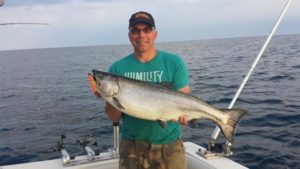As the leaves begin to change and the days begin to shorten many of us will begin to dust of our usual autumn items. We will head to our garages, basements, and attics in search of our archery equipment, camouflage, goose decoys, and other exciting fall toys. At the same time many of us will begin to file away our fishing equipment for next season. Although Michigan is a fantastic hunting destination, many of us forget about the terrific fall fishing that our great state has to offer, especially in Lake St. Clair and Lake Erie.
When most of us think of Michigan fishing in the fall, we generally think of the thousands of salmon that run up their native rivers as the spawning run concludes. This annual ritual gathers crowds of people from all across the country who come to fill their tags with a cooler full of arm bending Chinook salmon. This is a very popular activity but along with hunting, it causes people to overlook the great fall yellow perch fishing that the Great Lakes have to offer.
As fall begins and the temperatures begin to cool, the perch that inhabit our Great Lakes do what many animal do this time of the year: feed very heavily to prepare for the upcoming winter. But the perch have another reason to feed. Much like walleye, perch spawn early in the spring which causes an extra need for energy. Much of this energy must be stored during the heavy feeding patterns of the fall.
During the summer months the majority of adult perch can usually be found in deep water as they forage on the baitfish that inhabits these waters. As the water begins to cool during the late summer, these large schools of fish start their migration back toward the shallow water where they will spend the rest of the year.
Early in the season when the water is still relatively warm (in the 60 to 70 degree range) it is a good idea to begin your perch fishing trip in deeper water. There will likely be some fish in shallow water but this time of the season they will likely be smaller fish than most anglers are in search of. The jumbo perch that most fisherman desire, are normally in the deeper water schools. During this time of the year start fishing in deep water, and if you don’t experience success move locations often. Perch fishing is generally done at anchor, but that may not always be the best approach. If the weather is favorable and the wind is calm it may be best to start by drifting until you locate a school of active fish, and then drop the anchor in order to stay on top of those fish. This can drastically reduce the time it takes to locate active fish and make for a much more productive day on the water.
As the season progresses and the nights begin to cool, the water temperatures will begin to drop, sometimes as much as a few degrees in a single night. This drastic change in water temperature will cause the fish to gradually move toward the shallows. When this happens, don’t be afraid to go too shallow. Some of my best late season perch fishing has been done in five to seven feet of water, very close to the shoreline.
It is also very important to pay attention to detail, during this time of the year. Weather in Michigan is surely unpredictable, but autumn will no doubt bring some cool, windy days that will completely mix the water up. As you are motoring out onto the water watch your fish finder for any significant change in water temperature, as this likely hold fish. Depending on how cool the water is I will usually try to fish the warm side of the break, but if it is not happening there I will quickly move to the cold side and try my luck there.
Shallow water structure is also a hotspot for fall perch feeding activity. Keep an eye on your graph for drop-offs and small humps that can hold fish. An example of this is the Michigan dumping grounds of western Lake Erie, which is a hotspot not only for fall perch but also for early season walleye fishing. During this time of the year I have had some very good fishing in some very shallow water, often as little as five feet. All too often perch fisherman target water that is too deep, and thus have drastically reduced results. The general rule for perch fishing is the later it is in the year, the shallower the water you should be fishing in. This doesn’t always hold true, but it is definitely a good guideline to follow.
There are a few other things that can be done to increase your odds of filling up a bucket full of jumbo perch. A trick that charter captains have used for years is to leave a motor running at an idle while fishing. This seems to help attract fish from the surrounding area as well as hold the fish in the area for a longer period of time. Using a mud anchor is also a very effective technique for attracting fish. If you aren’t familiar this is simply a mushroom anchor with long bolts protruding through the bottom of the anchor. These are not used to hold the boat stationary, but rather to stir up the mud on the bottom and attract a school of fish.
So as this fall approaches remember that waterfowl, small game, and deer aren’t the only critters that you can pursue on your next trip outdoors. Don’t miss the opportunity to get on the water one last time and enjoy the great perch fishing that our great state has to offer.

